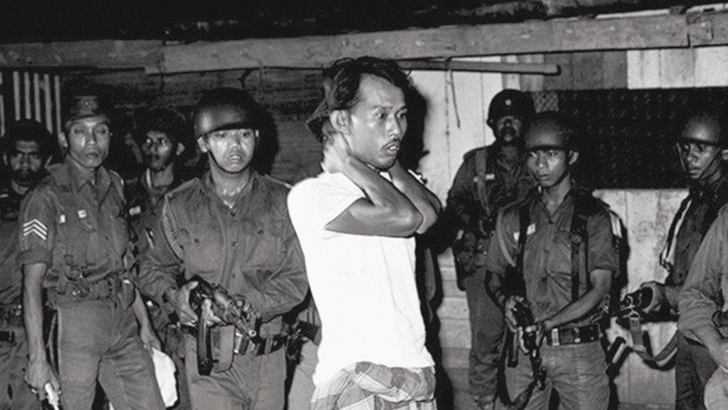A forgotten massacre on our doorstep

The systematic political murder of around 1 million people in Indonesia began on 1 October 1965 and lasted around three years. The violence was accompanied by mass arrests, probably hundreds of thousands going in and out of ad hoc prisons between 1965 and 1968.
Almost 20,000 were kept in prisons and camps until 1979. Murder, torture and imprisonment, accompanied by a sustained propaganda campaign, constituted an intense reign of terror. The targets were members and supporters of the Indonesian Communist Party (PKI), the left wing of the Indonesian National Party (PNI) and the mass organisations aligned with them.
Also targeted were other smaller left wing parties, such as the Indonesia Party (Partindo) and the Young Communists Movement (Acoma). The PKI was the largest and most rapidly growing of these forces. Its membership and support had grown from tens of thousands in the early 1950s to probably more than 20 million people in 1965, when there were approximately 35-40 million Indonesians of voting age.
Background
Between 1960 and 1965, the membership and general support for the PKI and the left PNI increased dramatically. This was due to two main factors. First, President Sukarno, the country’s most popular leader, president since 1945 and the central figure of the mass movement against colonialism before independence, escalated his open support for the idea of “socialism a la Indonesia”.
He also advocated an international alliance of all “new emerging forces”, comprising the socialist bloc, progressive newly independent states and democratic mass movements, such as the civil rights movement in the United States. He consistently spoke against communist phobia.
This massively legitimised left wing ideology. Second, the left, led by the PKI, waged a campaign against the corruption in the state owned companies under military management, for worker representation in these companies’ management, and for redistribution of land from large landholdings to exploited, impoverished, landless peasant farmers. In 1965, Indonesia was overwhelmingly an agricultural economy, with almost no manufacturing sector.
While Sukarno increasingly supported the PKI, he was not able to bring it into the government in any serious way because the army was opposed to having it in the cabinet. The Communists had won some mayoral positions in key cities after local elections in 1957. Sukarno was seeking greater unity between the PNI, the PKI and the Islamic Nahdatul Ulama and was waiting for the left to recruit a larger portion of the officer corps.
The PKI, through its newspaper, escalated a campaign for Sukarno to appoint more PKI members to the cabinet and other positions. The PKI and all the parties had, by 1963, given up on holding elections again, surrendering to Sukarno the right to resolve the question of which parties would be included in the government.
Meanwhile, openly right wing parties were banned. In these conditions, giving up on defending the democratic gains of earlier struggles laid the basis for attempts at conspiratorial resolutions to the situation.
Conspiracy
The pretext to launch the mass murders was a failed conspiracy by the 30 September Movement, led by middle rank army officers, but also organised by the PKI chairperson, D.N. Aidit, and a party Special Bureau that reported only to Aidit. Aidit never reported his involvement to the PKI Central Committee.
The officers mobilised left-oriented army forces in an attempt to remove rightist generals at the top of the army hierarchy.
General Suharto, head of the Army Strategic Command, mobilised his soldiers to quash this conspiracy. As the officers’ plan collapsed, they executed several generals. When President Sukarno heard what was going on, he called on the officers to stop. The conspiracy further unravelled, but the leaders issued a futile statement decommissioning Sukarno and his cabinet.
Suharto’s forces quickly captured all the conspirators. He alleged that the PKI had attempted a coup d’état against the government. Suharto’s group immediately launched a propaganda campaign and the killings and terror against the PKI and the left.
The political leadership of the Suharto group was backed by the mobilisation of the military structure to organise the mass killings over the next three years. The killings were carried out either by the military or by death squads made up of urban lumpen elements or the families and supporters of rural landowners.
Sukarno spoke out at every opportunity against the killings and the terror and the bans and suppression of the PKI and the left, defending their right to be involved in politics. When the killings also spread to ethnic targets, he also spoke out strongly against that.
His speeches, however, were no longer broadcast on radio or reported in the media. He was de facto under arrest, and gradually forced to cede real power to Suharto, who gained a “formal mandate” to restore order and security. All activity by the PKI and all the publications and writings of Sukarno, the PKI and the left were banned. Sukarno was later formally arrested.
Most of the leadership of the PKI, the left PNI, Partindo, Acoma and aligned unions and mass organisations were quickly captured and killed. A few leaders survived to be imprisoned.
Most of the leadership and membership were caught completely by surprise and were not prepared for the onslaught that hit them. They were unable to defend themselves or even organise to go underground. Only a few were able to carry out effective underground activity against the government, and only until 1968.
The killings were celebrated by the governments of the United States, United Kingdom, Japan and Australia, among others. Later, former Central Intelligence Agency operatives admitted that the US embassy gave lists of PKI members to the Suharto government.
In July 1966, Australian Prime Minister Harold Holt commented in the New York Times, “With 500,000 to a million communist sympathisers knocked off … I think it’s safe to assume a reorientation has taken place.”